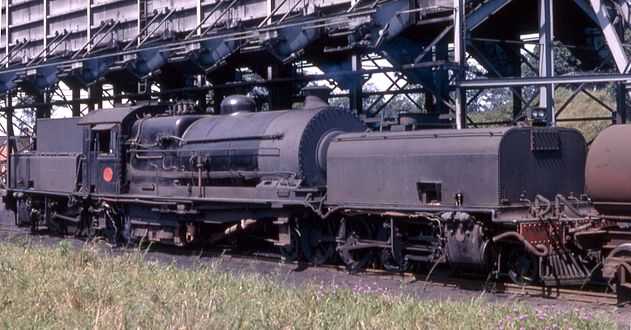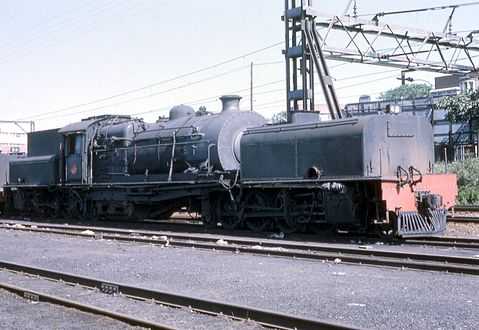South African Class GE 2-8-2+2-8-2
| South African Class GE 2-8-2+2-8-2 | |
|---|---|
|
Class GE no. 2269, circa 1930 | |
| Type and origin | |
| Power type | Steam |
| Designer | Beyer, Peacock and Company |
| Builder | Beyer, Peacock and Company |
| Serial number | 6193-6198, 6339-6348, 6716-6717 [1][2] |
| Model | Class GE |
| Build date | 1924-1930 |
| Total produced | 18 |
| Specifications | |
| Configuration | 2-8-2+2-8-2 "Double Mikado" Garratt |
| Gauge | 3 ft 6 in (1,067 mm) Cape gauge |
| Leading wheel diameter | 28.5 in (724 mm) |
| Driver diameter | 46 in (1,170 mm) |
| Trailing wheel diameter | 28.5 in (724 mm) |
| Wheelbase |
Total: 70 ft (21.336 m) Engines: 12 ft 9 in (3.886 m) coupled 22 ft 10.5 in (6.972 m) total, 2260-2275 22 ft 11 in (6.985 m) total, 2276-2277 |
| Length |
76 ft 8.75 in (23.387 m) 2260-2275 76 ft 8.25 in (23.374 m) 2276-2277 |
| Height | 12 ft 11.6875 in (3.954 m) |
| Frame | Plate frame, 35 ft (10.668 m) between pivot centres |
| Axle load |
13.45 long tons (13.7 t) on 7th driver, 2260-2275 13.15 long tons (13.4 t) on 2nd driver, 2276-2277 |
| Weight on drivers |
103.5 long tons (105.2 t) 2260-2275 102.75 long tons (104.4 t) 2276-2277 |
| Locomotive weight |
240,800 lb (109.2 t) empty 148.4 long tons (150.8 t) w/o 2260-2275 147.9 long tons (150.3 t) w/o 2276-2277 |
| Fuel type | Coal |
| Fuel capacity | 9 long tons (9.1 t) |
| Water capacity |
3,300 imp gal (15,000 l) front 1,300 imp gal (5,900 l) rear |
| Boiler |
6 ft 9 in (2.057 m) inside diameter 11 ft 3 in (3.429 m) inside length 7 ft 9.25 in (2.369 m) pitch |
| Boiler pressure | 180 psi (1,240 kPa) |
| Firegrate area | 52 sq ft (4.831 m2) |
| Heating surface: – Tubes |
288 tubes 2 in (50.8 mm) diameter 36 tubes 5.5 in (140 mm) diameter 2,374 sq ft (220.552 m2) |
| – Flues | 27 sq ft (2.508 m2) 2276-2277 only |
| – Firebox |
215 sq ft (19.974 m2) 2260-2265 202 sq ft (18.766 m2) 2266-2277 |
| – Total |
2,589 sq ft (240.526 m2) 2260-2265 2,576 sq ft (239.318 m2) 2266-2275 2,603 sq ft (241.827 m2) 2276-2277 |
| Superheater area |
362 sq ft (33.631 m2) 2260-2265 349 sq ft (32.423 m2) 2266-2275 364 sq ft (33.817 m2) 2276-2277 |
| Cylinders | Four |
| Cylinder size |
18 in (457 mm) bore 2260-2275 19 in (483 mm) bore 2276-2277 24 in (610 mm) stroke [1][3] |
| Valve gear | Walschaerts [4] |
| Performance figures | |
| Tractive effort |
At 75% boiler pressure: 45,640 lbf (203.0 kN) 2260-2275 50,850 lbf (226.2 kN) 2276-2277 |
| Career | |
| Operator(s) | South African Railways |
| Class | Class GE |
| Number in class | 18 |
| Number(s) | 2260-2277 |
| Delivered | 1925-1931 |
| First run | 1925 |
| Withdrawn | 1979 |
The South African Class GE 2-8-2+2-8-2 of 1925 is a South African steam locomotive from the South African Railways era.
Between 1925 and 1931 the South African Railways placed eighteen Class GE Garratt articulated locomotives with a 2-8-2+2-8-2 Double Mikado type wheel arrangement in service.[1][3][4]
Manufacturer
In 1924 specifications were prepared by the South African Railways (SAR) for the Class GE 2-8-2+2-8-2 Double Mikado type Garratt locomotive and an order for six locomotives was placed with Beyer, Peacock and Company (BP). They were delivered and placed in service in 1925, numbered in the range from 2260 to 2265. The Class GE was the only Double Mikado Garratt type to see service on the SAR.[1][3][4]
The locomotives proved to be most successful and a second order for ten was placed with BP in 1926. These were numbered in the range from 2266 to 2275 when they were delivered and placed in service in 1927. A third order for two locomotives, also from BP, followed in 1930, numbered 2276 and 2277 and placed in service in 1931.[1][3][4]
Characteristics
The Class GE Garratt was designed as a heavy goods locomotive for use on light 60 pounds per yard (30 kilograms per metre) rail and was an enlargement of the Class GD 2-6-2+2-6-2. They were the first eight-coupled Garratts to be built for the SAR. At the time of their introduction they were, on a tractive effort basis, the most powerful locomotives operating on light track in Africa and the Southern Hemisphere.[3][4][5]
The locomotives of the three orders were visually distinguishable from one another. The first two orders were mechanically identical, but the second batch had redesigned water tanks with rounded top corners, and inset tops on their coal bunkers to improve rearward vision for the crew. They also had slightly smaller firegrate and superheater areas than the first batch.[3][4][5]
The two locomotives in the third batch were similar in general appearance to those in the second, but with arch tubes added, wider cabs and larger cylinders to make them more powerful. All of them had Belpaire fireboxes, plate frames, Walschaerts valve gear and were superheated.[3][4][5]
Service
They were placed in service working goods traffic on the light rail sections from Zeerust to Mafeking and from Pretoria to Pietersburg. Some were later allocated to the Natal North Coast, and a few were still later also used for a brief period to work across the Montagu Pass between George and Oudtshoorn.[1][4][5]
Their final duties were on the Nkwalini branch in Natal, where the last survivors of the original eighteen locomotives were finally replaced by Class GEA and Class GO Garratts. The last ten Class GE locomotives were withdrawn from service in April 1975.[4][5]
Sides illustrated
The main picture shows no. 2269, one of the second batch of Class GE locomotives, c. 1930. This locomotive still has the old bell link-and-pin type couplers.
The locomotives depicted below have all been equipped with the AAR knuckle couplers that were introduced on the SAR in the late 1940s. The coupler on no. 2274 is one of the type that was used on locomotives during the coupler transition period, with a groove in the block of the coupler to enable the locomotive to couple to rolling stock that was still equipped with the older link-and-pin type couplers.
-

No. 2266, first of the second batch, c. November 1971
-

No. 2274 at Stanger Loco Depot, c. September 1966
-

No. 2276, first of the third batch, at Greyville, c. May 1971
See also
- Articulated locomotive numbering and classification
- List of South African locomotive classes
- South African locomotive history
- The 2-8-2+2-8-2 "Double Mikado"
References
|
- ↑ 1.0 1.1 1.2 1.3 1.4 1.5 Holland, D.F. (1972). Steam Locomotives of the South African Railways, Volume 2: 1910-1955 (1st ed.). Newton Abbott, Devon: David & Charles. pp. 43–45. ISBN 978-0-7153-5427-8.
- ↑ Hamilton, Gavin N., The Garratt Locomotive - Garratt Locomotives produced by Beyer, Peacock, retrieved 10 November 2012
- ↑ 3.0 3.1 3.2 3.3 3.4 3.5 3.6 South African Railways and Harbours Locomotive Diagram Book, 2’0” & 3’6” Gauge Steam Locomotives, 15 August 1941, as amended
- ↑ 4.0 4.1 4.2 4.3 4.4 4.5 4.6 4.7 4.8 Paxton, Leith; Bourne, David (1985). Locomotives of the South African Railways (1st ed.). Cape Town: Struik. p. 91. ISBN 0869772112.
- ↑ 5.0 5.1 5.2 5.3 5.4 Durrant, A E (1989). Twilight of South African Steam (1st ed.). Newton Abbott, London: David & Charles. p. 111. ISBN 0715386387.
.jpg)